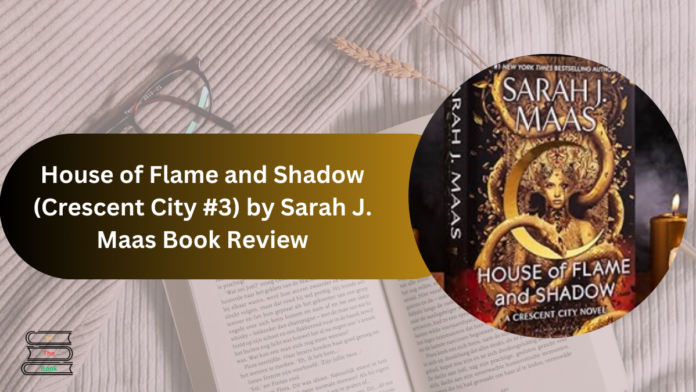My experience with House of Flame and Shadow, Sarah J. Maas’s third instalment in the Crescent City series, was lukewarm. This book follows Bryce Quinlan, a former party girl turned Starborn heir, as she navigates her complex life, attempting to overthrow the Asteri and save Lunathion. However, several significant issues detracted from my overall enjoyment.
Contents
A Complex Web of Characters and Plots
The Crescent City series has yet to be my favourite among Maas’s works. While I struggled to finish the second book, House of Sky and Breath, the revelations about Asteri and the cliffhanger ending sparked my interest in House of Flame and Shadow.
After completing Crescent City 3, I have mixed emotions about the book. The conclusion of House of Flame and Shadow suggests a similar format to A Court of Thorns and Roses, where the first three books focus on the main protagonist’s story, followed by novels centred around secondary characters.
This leaves me with the impression that House of Flame and Shadow is a series-ender, although Bryce’s story may continue in some capacity.
A Massive Book with Multiple Elements
House of Flame and Shadow is a substantial book featuring many characters, plots, and world-building. I will divide my review into sections to organize my thoughts, discussing characters, plot, world convergence, and additional thoughts.
Spoiler Alert
Please note that my review contains significant spoilers for the series. If you still need to finish Crescent City 3, proceed with caution.
Crescent City 3: A Mixed Bag
The highly anticipated Avengers-style plot twist at the end of the sequel drew me into House of Flame and Shadow, the third book in the Crescent City series. Since its announcement, fans have speculated about the inclusion of A Court of Thorns and Roses (ACOTAR) characters and the impact on the remaining ACOTAR books. I have mixed feelings about the ACOTAR characters’ inclusion in Crescent City 3.
A Refreshing Perspective on Nesta
My favourite aspect was seeing Nesta after the events of A Court of Silver Flames. Her portrayal in Crescent City is more favourable than in ACOTAR, offering a refreshing outsider’s perspective. The bonus chapters from Ember’s perspective were delightful, showcasing Nesta’s supportive relationships.
A Divided Opinion on ACOTAR Characters
However, some bonus chapters portray ACOTAR characters in an unfavourable light. Rhys’s characterization in the Ember bonus chapter could have been better, and Cassian’s actions may also displease some readers. It is essential to consider multiple perspectives. Nesta’s actions can be seen as reckless, Cassian is torn between his mate and court leader, and Rhys’s actions align with his protective nature.
A Lukewarm Inclusion of the ACOTAR World
The overall inclusion of the ACOTAR world was mediocre. While I appreciated the minimal impact on the ACOTAR world, the book connection felt underwhelming. The epic convergence of worlds that many readers expected did not materialize. Including the ACOTAR characters felt boring, with Prythian only being focused on in the book’s first third. The interactions between Bryce and ACOTAR characters felt like info-dumping rather than meaningful plot progression.
My review’s central theme is my mixed feelings about various aspects of Crescent City 3, including the ACOTAR world. Now, let us move on to the characters!
CHARACTERS
My sentiments regarding the characters in House of Flame and Shadow are decidedly mixed, much like my feelings about including the ACOTAR world. While I have grown fond of several characters in this series and believe some stand out within Sarah J. Given Maas’s extensive universe, the Crescent City series has a weaker cast than Throne of Glass (TOG) or ACOTAR.
Let us begin with the supporting cast, which, like in Maas’s other books, is extensive. However, unlike in TOG or ACOTAR, I find it challenging to form strong connections with the characters in Crescent City.
I can easily distinguish each character in Maas’s other series and understand their significance to the plot, but Crescent City differs. Some side characters, such as Flynn and Declan or Juniper and Fury, feel somewhat indistinguishable and lack the importance I expected, given their close relationships with Bryce and Ruhn.
Crescent City shares similarities with TOG in its multiple POVs and numerous side characters. However, whereas I eagerly anticipated returning to each character’s POV in TOG, a few POVs in Crescent City captivate me less, such as Tharion and Ithan’s. In Maas’s other books, each plot thread was satisfactorily resolved, even with the knowledge that more books would follow.
In contrast, Tharion and Ithan’s storylines felt too open-ended, with too many loose ends, seemingly setting up future novels, which, according to Maas, are far down the publishing line.
Beyond their plot contributions, the supporting cast in Crescent City lacked the exceptional strengths and skills exhibited by Aelin’s court and Rhysand’s inner circle. This can be attributed to the fact that most characters in Crescent City need to be trained warriors and inhabit a more modern world.
However, this aspect aligns with the series’ overarching theme, which highlights the potential for anyone to make a positive impact and become a hero. Nevertheless, I had reservations about this group’s ability to defeat the Asteri, as their success seemed more a result of circumstance than masterful planning.
Moving on to the main cast, Bryce, the central character, demonstrated significant growth throughout the series. In House of Flame and Shadow, she evolved into a leadership role, showcasing some of the cleverness and strategic thinking characteristics of Sarah J. Maas’s heroines.
However, Bryce’s development came at the cost of her empathetic nature, a defining trait in previous books. Her reduced empathy towards Hunt and her friends, who had suffered greatly, was disappointing.
On the other hand, Lidia’s character shone brightly in House of Flame and Shadow. I appreciated the opportunity to delve deeper into her backstory and witness her growth. Lidia embodied the qualities I admire in Sarah J. Maas’s heroines: she learned from her past mistakes, overcame guilt and shame, and fought for those she loved.
Lidia was the true mastermind behind House of Flame and Shadow events. For most of the book, I was more invested in Lidia’s story and relationship with Ruhn than in Bryce and Hunt’s narrative.
Ultimately, my feelings towards the characters in Crescent City are mixed. While I adored Lidia, she was not the main protagonist. I needed Bryce to grow without sacrificing her endearing qualities, and I required more defined roles for the supporting cast to make the series comparable to Maas’s other works.
PLOT
I am not typically fond of series-enders written by Sarah J. Maas. In the original ACOTAR trilogy, A Court of Wings and Ruin was my least favourite due to its imbalance of fantasy and romance elements, particularly compared to its predecessor, A Court of Mist and Fury. Similarly, while I enjoyed Kingdom of Ash in the TOG series, it did not captivate me as much as Queen of Shadows or Empire of Storms, mainly due to its slower pace.
Maas’s series-enders are correct, but they do not usually resonate with me as much as her other works. I felt similarly about A House of Flame and Shadow, which concludes Bryce’s main storyline. Like A Court of Wings and Ruin, this book prioritizes fantasy over romance, which has both positive and negative aspects.
I commend Maas for her meticulous planning and attention to detail, evident in the intricate connections throughout multiple series. The world-building in Crescent City is impressive, and I appreciate the depth of background information. However, some of this information could have been presented more engagingly.
The first third of the book, which focuses on Bryce exploring a cave and learning about the past, felt slow and excessive. This storytelling style, which prioritizes telling over showing, persisted throughout the book and was particularly noticeable when the ACOTAR cast appeared.
This slow-burning narrative is characteristic of the CC series, which often builds up gradually before culminating in a dramatic conclusion. While this may frustrate some readers, fans of the series have likely come to expect this pacing. Nevertheless, I felt that A House of Flame and Shadow moved slightly slower than its predecessors, partly due to the info-dumping.
Compared to House of Sky and Breath, the fantasy and romance elements could have been more balanced in A House of Flame and Shadow. The romance scenes were less frequent and felt less organic. I was disappointed that the reunion between Bryce and Hunt was not more dramatic and that their interactions often involved dismissing each other’s emotions or disagreeing. On the other hand, I enjoyed Lidia and Ruhn’s romance, which took centre stage in this book.
ADDITIONAL THOUGHTS
I want to revisit my earlier comment regarding the bonus chapters in A House of Flame and Shadow. The trend of special editions and exclusive bonus chapters for different retailers has become excessive. The latest Crescent City book was released in five distinct editions, each containing unique bonus chapters. In the past, Bloomsbury would publish all bonus content online, but unfortunately, this was not the case with A House of Flame and Shadow.
I am not fond of bonus content unless it is universally accessible. It is disappointing that crucial, emotional moments were omitted from the standard publication and only available in select editions. For instance, Lidia and Ruhn’s bonus content contained significant scenes that technically occurred within the narrative but might be missed by many readers.
Overall, while A House of Flame and Shadow was a good book, I had higher expectations. I am sad to bid farewell to Bryce’s story, and the nods to the first book in the series evoked strong emotions. However, certain aspects could have been improved. I am giving this book 3.5 out of 5 stars, reflecting my mixed feelings towards it.

Ross, an exam specialist with a passion for education, writes comprehensive articles on exam results and admit cards. His expertise ensures students receive reliable information and useful tips to excel in their exams.



























